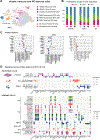Molecular and spatial landmarks of early mouse skin development
- PMID: 37591247
- PMCID: PMC11088744
- DOI: 10.1016/j.devcel.2023.07.015
Molecular and spatial landmarks of early mouse skin development
Abstract
A wealth of specialized cell populations within the skin facilitates its hair-producing, protective, sensory, and thermoregulatory functions. How the vast cell-type diversity and tissue architecture develops is largely unexplored. Here, with single-cell transcriptomics, spatial cell-type assignment, and cell-lineage tracing, we deconstruct early embryonic mouse skin during the key transitions from seemingly uniform developmental precursor states to a multilayered, multilineage epithelium, and complex dermal identity. We identify the spatiotemporal emergence of hair-follicle-inducing, muscle-supportive, and fascia-forming fibroblasts. We also demonstrate the formation of the panniculus carnosus muscle (PCM), sprouting blood vessels without pericyte coverage, and the earliest residence of mast and dendritic immune cells in skin. Finally, we identify an unexpected epithelial heterogeneity within the early single-layered epidermis and a signaling-rich periderm layer. Overall, this cellular and molecular blueprint of early skin development-which can be explored at https://kasperlab.org/tools-establishes histological landmarks and highlights unprecedented dynamic interactions among skin cells.
Keywords: embryonic development; fibroblast lineage divergence; hair follicle; lineage tracing; molecular and anatomical landmarks; mouse skin; panniculus carnosus muscle; periderm; single-cell RNA sequencing; spatial analysis.
Copyright © 2023 The Authors. Published by Elsevier Inc. All rights reserved.
Conflict of interest statement
Declaration of interests The authors declare no competing interests.
Figures







References
-
- De Falco M, Pisano MM, and De Luca A (2014). Embryology and Anatomy of the Skin. In Current Clinical Pathology. Skin cancer, Baldi A, ed. (Springer Science+Business Media; ), pp. 1–15. 10.1007/978-1-4614-7357-2. - DOI
Publication types
MeSH terms
Grants and funding
LinkOut - more resources
Full Text Sources
Molecular Biology Databases

